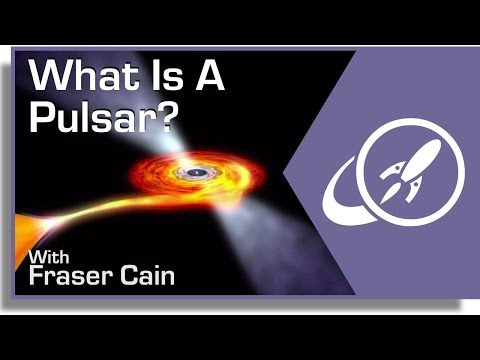This question comes from William. He writes “Hi Fraser, I was wondering if you could do a video on pulsars like you did on quasars.” You got it. Stars are held in perfect balance between the pressure of gravity pulling them inward, and the outward force of radiation. Once stars runs out of fuel, they collapses in on themselves – it’s the amount of mass decides what happens next. The most massive stars detonate as supernovae, and can explode or collapse into black holes.
If they’re less massive, like our Sun, they blast away their outer layers and then slowly cool down as white dwarfs. But for stars between and times the mass of the Sun, they may still become supernovae, but they just don’t have enough mass to make a black hole. These medium mass objects end their lives as neutron stars, and some of these can become pulsars or magnetars. Gravity overwhelms the atomic bonds of the matter in a neutron star, crushing protons and electrons together into neutrons. This is how they get their name. A star that used to be more than a million kilometers wide is now less than 20 kilometers across. This material is so dense, that a single sugar cube’s worth weigh about 100 million tonnes on Earth. And you would need to be traveling 100,000 km/s to escape a neutron star’s pull – about 1/3rd the speed of light.
So that’s how you get a neutron star. But what about these pulsars? When these stars collapse, they maintain their angular momentum. But with a much smaller size, their rotational speed increases dramatically, spinning many times a second. This relatively tiny, super dense object, emits a powerful blast of radiation along its magnetic field lines. Although this beam of radiation doesn’t necessarily line up with it’s axis of rotation. And so, from here on Earth, astronomers detect an intense beam of radio emissions several times a second, as it rotates around like a lighthouse beam. This is a pulsar. The first one was detected in 1967 by Jocelyn Bell Burnell and Antony Hewis. They detected a mysterious radio emission coming from a fixed point in the sky that peaked every seconds. Although they were certain it had a natural origin, they named it LGM-1, which stands for “little green men”, and subsequent discoveries have helped astronomers discover the true nature of these strange objects.
Pulsars have been discovered emitting many different wavelengths of light, from radio to visible and even X and gamma rays. There have been a total of 1600 found so far, and the fastest discovered emits 716 pulses a second. When a pulsar first forms, it has the most energy and fastest rotational speed. As it releases electromagnetic power through its beams, it gradually slows down. Within 10 to 100 million years, it slows to the point that its beams shut off and the pulsar becomes quiet. When they are active, they spin with such uncanny regularity that they’re used as timers by astronomers. Pulsars help us search for gravitational waves, probe the interstellar medium, and even find extrasolar planets in orbit. It has even been proposed that spacecraft could use them as beacons to help navigate around the Solar System. On NASA’s Voyager spacecraft, there are maps that show the direction of the Sun to 14 pulsars in our region. If aliens wanted to find our home planet, they couldn’t ask for a more accurate map.
I hope that helps, William..
